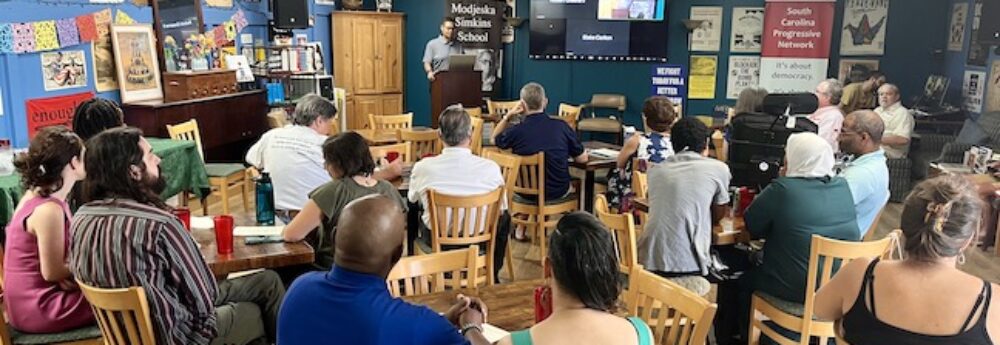By Susan Corbett
Chair, SC Chapter, Sierra Club
During the recent 2010 gubernatorial debate, it seemed apparent the candidates have decided the energy future of South Carolina: nukes, nukes and more nukes.
Virtually every candidate spouted nuclear power as a “clean, green, homegrown” energy source that will be the solution to climate change and our energy needs. This characterization of nuclear as clean and homegrown is one of the biggest hoaxes perpetrated by the nuclear industry since the demise of their first round of economic boondoggles. (64 reactors left unfinished in the 80’s, in various stages of construction).
I cannot for the life of me understand how these candidates perceive nuclear as “homegrown’. Uranium is not mined in South Carolina, and most U.S. uranium is very low grade, making it uneconomical. High grade uranium comes from foreign sources, and in fact most of the uranium we use presently comes from: Russia. Strike One – another foreign fuel source.
But how about the manufacturing and construction of nuclear reactors, that’s homegrown, right?
Wrong. At the recent Public Service Commission hearing where SCE&G asked for the first of what we believe will be many deadline extensions, it was revealed that virtually all major components of nuclear power plants are purchased in foreign countries like Korea, Japan and Italy.
In fact, the United States doesn’t even have forges large enough to make the reactor vessels, steam generators and other large parts needed for reactors. We are totally dependent on these foreign companies and the one or two manufacturers, like the plant at Doosan, Korea, for our big reactor parts. We must get in line and wait our turn to get these key components, and pay whatever fee these companies charge, with all the money going out of the U.S. Strike Two: all major parts produced outside the U.S. by foreign companies.
Two weeks ago, the usually permissive Nuclear Regulatory Commission rejected a modified version of the AP1000 reactor, designed by Westinghouse Electric Co., citing concerns about structural integrity.
This new design includes a mega-ton water containment system that sits perched on top of the shield building, using gravity to allow water to flow down around the reactor as a cooling system. The NRC review questioned the design of the shield building as suspect in withstanding earthquakes, tornadoes, air plane strikes or even high winds.
In other words, the major building that contains the reactor and ultimately shields us, the citizens, from the release of deadly radiation in the case of an accident, could itself fail. Although SCE&G assured the PSC these details would all get worked out, one must wonder about other design flaws, in an untested, unproven prototype reactor, which will operate in our backyard. Oh, and Westinghouse? It’s owned by Toshiba, a Japanese corporation. Strike Three: a foreign-owned corporation with untested, unproven reactor design with serious safety questions.
Here’s my idea of a homegrown energy source: Up in Greenville, we have a U.S. corporation, G.E., producing wind turbines. They are using American-made parts and American workers. We could take these turbines down to the coast, and using our excellent port facilities at Charleston, and our excellent port facility workers, construct large wind farms off our coast to tap into the 2-4 Gigawatts ( that’s a HUGE amount) of offshore wind we know is available. We could use free American fuel to power all our coastal cities and then some, and never send a dollar out of state. Then we could help build wind farms up and down the Atlantic coast using our own homegrown technology and expertise.
Couple offshore wind with solar and rigorous energy efficiency programs that also put S.C. citizens to work, and we have a roadmap to true homegrown energy independence for South Carolina.

Very informative read, thank you!